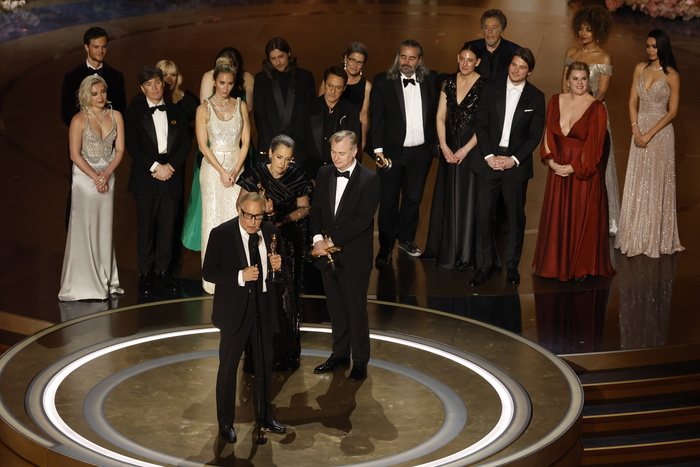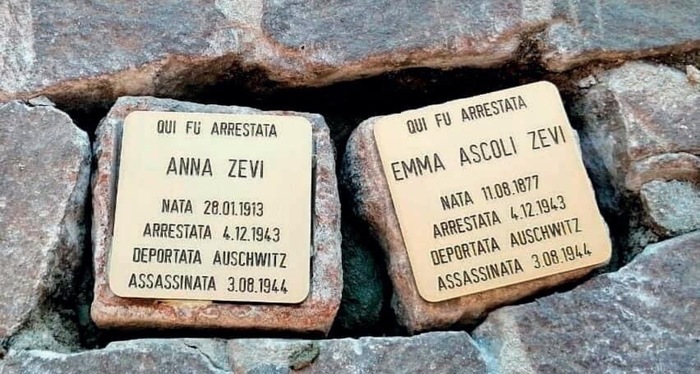AreaRead the video transcript expand here
He touches the shoes in a particularly careful way. Every single one.
Respectful, but also with a professional eye.
Andrzej Jastrzębiowski is curator.
He works in the laboratories of the Auschwitz Memorial.
A team of specialists meticulously takes care of the preservation of all the things that have remained from the death factory.
You fight against time, because everything here is threatened with decay.
This film shows how much effort and effort the employees put into commemorating the Holocaust, day after day, shoe by shoe.
A challenging task, because the way to work leads to the former concentration camp every day.
For Jastrzębiowski and the others, the work creates a deep bond with the victims.
The shoes he's working on belonged to a woman.
Andrzej Jastrzębiowski, Conservator of the Auschwitz Memorial:
»The shoes are an example of objects that are very, very personal because they are directly linked to the victims.
These shoes belonged to the victims.
Every shoe can tell us a story – the story of its owner.«
It's just one of about 110,000 shoes in Auschwitz.
You can find most of them in the exhibition.
The shoes make the scale of the killing machine more tangible – everyone has shoes, they make it easier to identify with the victims.
Even these mountains are only a fraction of the shoes of the at least 1.1 million people who were murdered in Auschwitz.
The sight of the approximately 8,000 tiny children's shoes is particularly hard to bear.
They, too, are crumbling more and more.
The conservation team is determined to preserve them - and not just for symbolic reasons.
They commemorate the murder of over 200,000 children and young people in Auschwitz.
Every single shoe is evidence of war crimes.
Just like the suitcases in which the people who were deported to Auschwitz brought their belongings with them.
They thought they would only be resettled.
Baggage was confiscated upon arrival at the ramp.
Even this amount is overwhelming and yet only a part.
Many more suitcases are in stock.
Magdalena Emilewicz-Pióro, employee of the Auschwitz Memorial Collections:
»We come to the camp area every day.
We enter every single room daily to check the temperature and humidity.
Storage is actually the biggest issue when it comes to the decay of these items.
Because the number of objects in these collections is immense.
We are unable to preserve every single object.
That's why we have this modern storage system that allows us to slow down the process of destruction.«
Marta Świętoń will work on this one suitcase for a month.
Even during her studies, the conservator specialized in the preservation of paper.
Most of the suitcases in Auschwitz are made of cardboard and cellulose or vulcanized fiber.
Marta Świętoń, Conservator at the Auschwitz Memorial:
»I've just started with this case.
The first step is to remove the dust that is on the surface, inside and outside.
And when I'm done with that, I'll get down to removing old paintwork from previous preservations.
Later I remove the active rust on the metal elements and then apply a protective layer to the metal elements.
And if you look at the objects, you can see that nothing has really changed.
That's something we always try to do here.
We're trying to preserve things, but in a way that doesn't really change their appearance.
We don't try to fix them."
Nothing beautify, nothing repair.
Preserving the authentic - that's the philosophy.
The traces of destruction and annihilation are inseparable from the objects.
They tell about the fate of their owners.
Marta Świętoń, curator at the Auschwitz Memorial:
“It becomes particularly clear when you come across some kind of inscription on the surface or some kind of information that the suitcase belonged to someone.
Because every inscription is like proof that a person was behind it.
Living proof that it's that person's property.
If we find that kind of information on the suitcase, we check the database to see who it belongs to and if there is any information about the person.”
The discovery of individual fates in the midst of the anonymity of the many victims always resembles a small sensation in view of the unimaginable number of exhibits.
Hanna Kubik, member of staff at the Auschwitz Memorial Collections:
“Sometimes in our restoration work we come across previously undiscovered clues left by their owners.
One such example is this shoe that belonged to a little girl: Vera Vohryzek.
Inside the shoe you can see the girl's first and last name, the number of the transport and the number under which she was registered as a prisoner.
Sometimes it happens that the tracks in the shoes are quite legible.
With the help of our archive we can get to know the personal history.
The little girl was born in the Czech Republic in January 1939 and at the age of three was sent to the Theresienstadt ghetto with her brother and mother.
After about six months in the ghetto, they were deported to Auschwitz.
Probably Vera,
her brother and mother perished in a gas chamber.
During our investigation we were able to establish that the girl's father also died in the camp: Max Vohryzek.«
Vera's father's photograph, taken during his registration at the camp, is in the archive, as is his death certificate.
The research provides exemplary evidence of the extermination of an entire family – little Vera's uncle was also deported to Auschwitz.
They found his suitcase.
How do you preserve the memory of the Holocaust at the site of the genocide?
The vast amounts of the victims' belongings were found after the liberation of Auschwitz on January 27, 1945, and although it has been 78 years, the collection is still open.
Things from private property still come to the memorial as donations or inheritances.
They are the personal memorabilia of the survivors.
Elzbieta Cajzer, head of the collections at the Auschwitz Memorial
:
“You
only recently decided to donate these objects to the museum, because only here can these objects serve as storytellers.
But also for more pragmatic reasons: private individuals are not able to obtain these items properly.
Of course there are some things that touch us employees in a very personal way.
The moment the last contemporary witnesses have disappeared, these objects will bear witness to their stories.
Stories of people who were here in Auschwitz.
Direct reports will no longer be possible.«
The challenges are complex.
Documents and papers are about microbiological damage, pH values, fading writing, damage from adhesive strips.
The conservation team is not only struggling with a huge amount of commodities, they are also struggling with the poor condition.
Much was damaged during the deportation or later when the Nazis tried to destroy the traces.
Valuable things they confiscated, either the camp SS personally or they brought the things back to the German Reich on the deportation trains.
At the time of the liberation, wagons filled with stolen blankets and clothing were still standing at the train ramp of the Auschwitz-Birkenau concentration camp.
The leftover belongings are mostly of poor quality.
But that's not the only problem.
Aleksandra Papis, Head of the Conservation Laboratory at the Auschwitz Memorial:
“Above all, there are no real solutions when it comes to conservation.
So that's an extra challenge.
We are pioneers.
What we do has hardly been done by other scientists before.
Usually we use contemporary materials.
There is no one to ask how something should be done.
Because we are the ones who are asked all the time how we did something or how to store certain materials, how to secure them.«
Two tons of human hair were found in the extermination camp when it was liberated.
It is still in the exhibition and will deteriorate there over time.
A quiet place.
On which, out of respect for the murdered, it is not allowed to talk, photograph or film.
The hair is part of the victim's body.
In order to protect their human dignity, it was decided that the hair would no longer be preserved as the only exhibit.
But everything else is – an unimaginable effort.
All conservation steps are analyzed, documented and digitized with special cameras.
If you leave the conservation laboratory in the Auschwitz 1 camp complex and go to Auschwitz-Birkenau, you will pass the so-called old Jewish ramp - work is also done here - the former cattle wagons with which people were transported to their deaths.
Here in Birkenau, the immense challenge for the conservation team takes on a completely different dimension.
Rafał Pióro, Deputy Director of the Auschwitz Memorial:
»Rescuing and preserving the memorial is an extraordinary challenge, as we are dealing with an immense size here.
We are talking about a huge site that is over 190 hectares.
We're talking about 150 buildings, 300 ruins, many kilometers of fences.«
It is very clear to see how the decay is progressing.
The barracks were built on swampy, damp ground, the structural substance is inferior.
Durability was unimportant in the construction of the death camp.
Now the ground is giving way, the walls are sagging under the weight of the roofs – collapse is imminent.
How do you get a concentration camp?
There is no master plan for this.
Jolanta Banaś-Maciaszczyk, Conservator at the Auschwitz Memorial:
»The construction that we see here on the western wall of the barracks is intended to straighten the wall.
This is a very important part of the whole building preservation process.
We are doing our best to bring the building back to its original form.
This essentially leaves the walls without major interventions.«
Huge halls protect the conservation work.
Two barracks are being worked on in parallel.
Change as little as possible, the principle also applies to the bunks: the degrading sleeping places of the prisoners should remain authentic.
Things are only renewed where it is really necessary.
Just like here with the building structure.
The employees lay all floor bricks exactly according to the original pattern.
Jolanta Banaś-Maciaszczyk, Conservator at the Auschwitz Memorial:
“Our work is complex and time-consuming.
The foundations take up a lot of our time.
First we have to secure the historical, so we preserve the authentic foundations.
The next task is to uncover the foundations.
The final step is insulation to protect it from water to ensure there are no moisture problems in the building.”
Preserve the horror lest it decay and be forgotten.
Here, where millions of suffering happened.
When talking to everyone in the team, you can feel how high the level of identification with the task is.
Emotionally, however, it remains a balancing act – between the necessary inner distance and everyday closeness.
Jolanta Banaś-Maciaszczyk, Conservator of the Auschwitz Memorial:
»Due to the history of this place, work in the former concentration camp of Auschwitz is certainly not easy.
But everyone who works here finds their own way of dealing with it.
I think that it is also important from this point of view that we keep discovering traces of different people during our work.
This is something incredibly valuable for all of us here.«







/cloudfront-eu-central-1.images.arcpublishing.com/prisa/GW4NRQMAIRA6VIIWOPCEZCQZRU.jpeg)
/cloudfront-eu-central-1.images.arcpublishing.com/prisa/QNGKAJVA35D7BER25KAR7IOHMM.jpeg)






